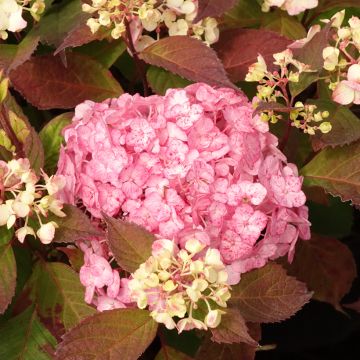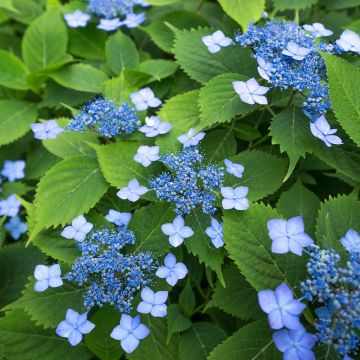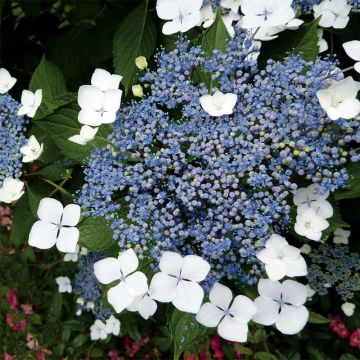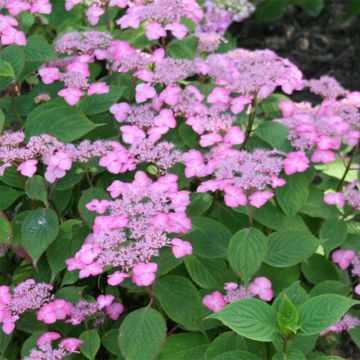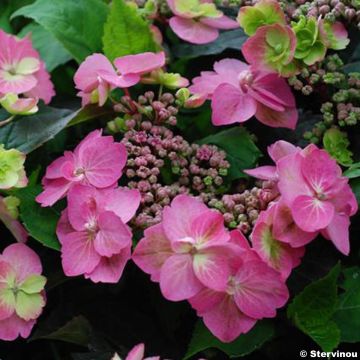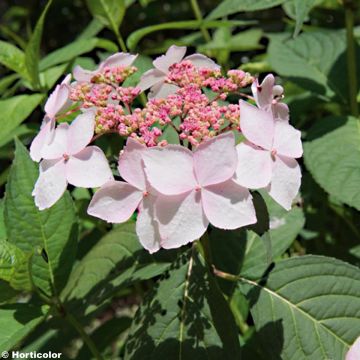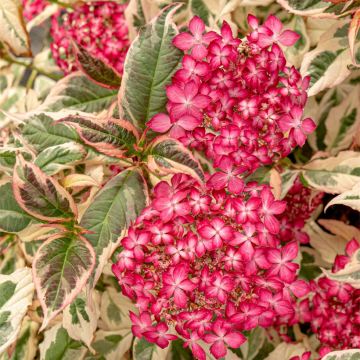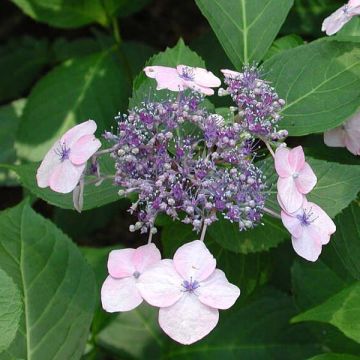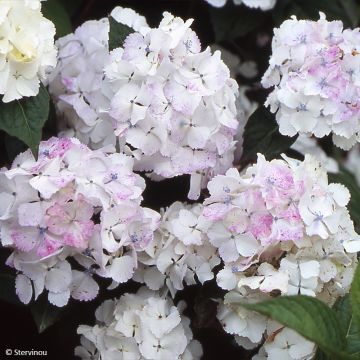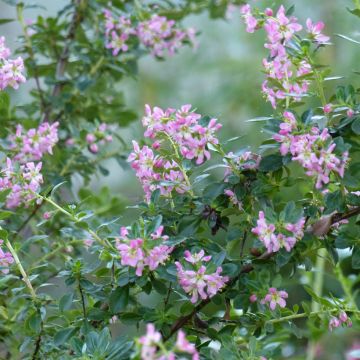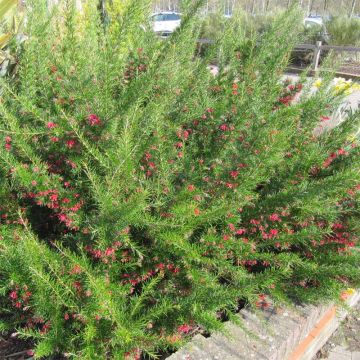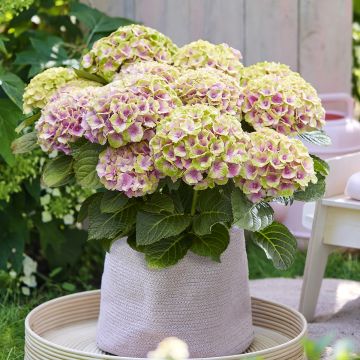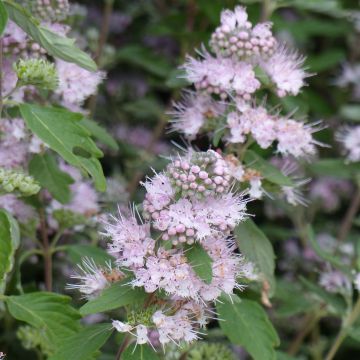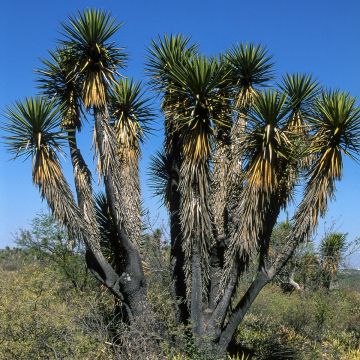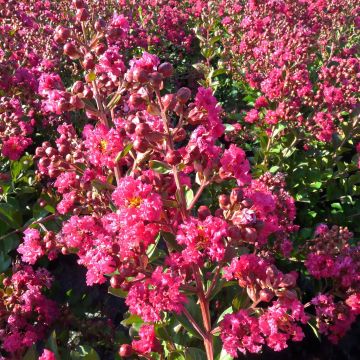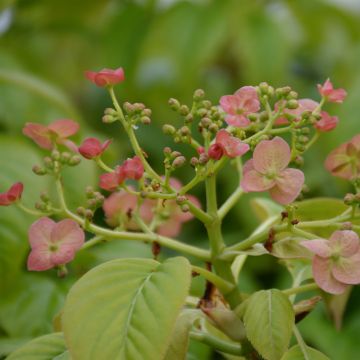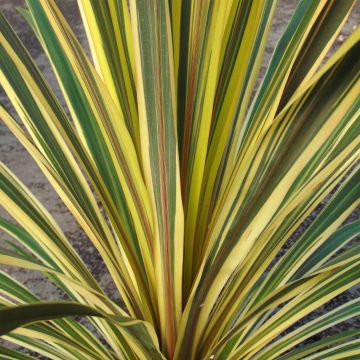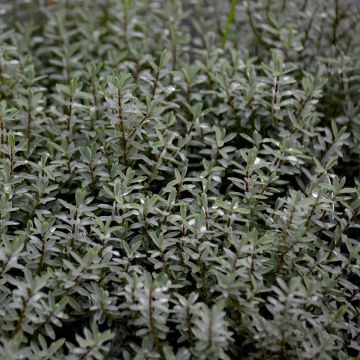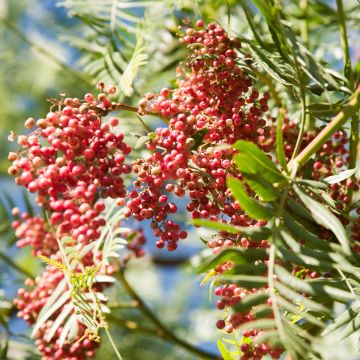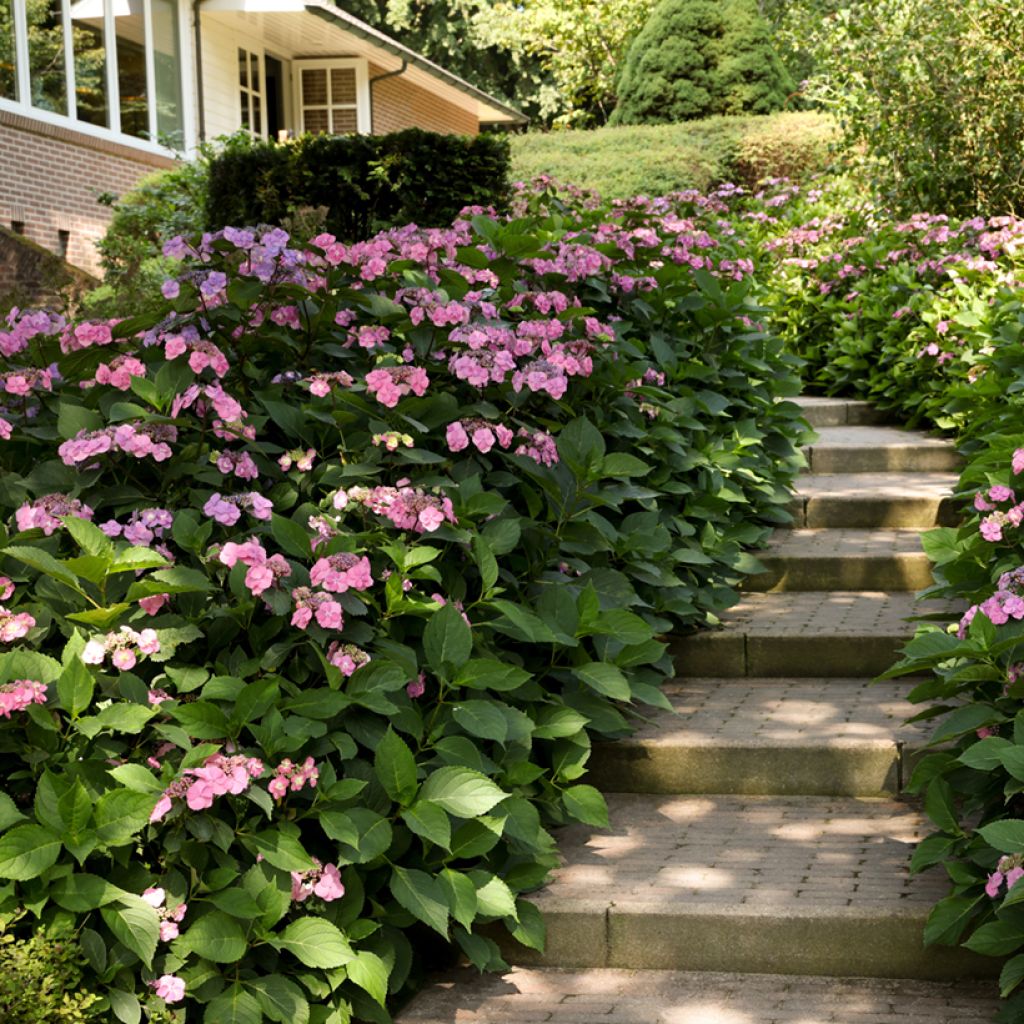

Hydrangea serrata Summer Glow
Hydrangea serrata Summer Glow
Hydrangea serrata Summer Glow®
Mountain Hydrangea, Tea of Heaven
This item cannot be shipped to the selected country
Delivery charge from €5.90
More information
Schedule delivery date,
and select date in basket
This plant carries a 24 months recovery warranty
More information
We guarantee the quality of our plants for a full growing cycle, and will replace at our expense any plant that fails to recover under normal climatic and planting conditions.
From €5.90 for pickup delivery and €6.90 for home delivery
Express home delivery from €8.90.
Does this plant fit my garden?
Set up your Plantfit profile →
Description
Hydrangea serrata 'Summer Glow' is a variety of Hydrangea with flat heads that is particularly attractive, both for its flowering and its autumn colours. Depending on the acidity of the soil, its long-lasting summer flowering will display in blue or pink. The large inflorescences bloom above the dark green foliage, which highlights them particularly well. In autumn, the leaves turn a deep red, thus ending the season beautifully. With moderate growth, this bush is perfectly suited for small gardens, as well as container cultivation.
Hydrangeas are the most important genus in the Hydrangeaceae family, from which they get their name. This family includes only 17 genera, the most well-known besides Hydrangea being Deutzia and Philadelphus (Mock Orange). Hydrangeas include mostly deciduous species of shrubs and climbers, although there are a few evergreens, such as Hydrangea seemanii. The genus name comes from the Greek words hydro (water) and aggeion (vase), referring to the shape of the fruits.
Hydrangea serrata is a species closely related to H. macrophylla, the parent of our garden Hydrangeas with large spherical heads. However, it is known to be slightly hardier due to its geographical origin. It grows up to 1500 m in the mountains of Japan and Korea, which explains its hardiness down to approximately -20°C. This Hydrangea forms a small bush about 1.50 m in all directions, with deciduous leaves carried by thin, often blackish stems.
'Summer Glow' is a horticultural variety with a more compact growth, reaching a height of approximately 1.25 m at maturity with a spread of only 1 m. The bush forms a dense clump, which is well-suited for low hedges. The leaves are opposite, lanceolate to elliptical, measuring from 5 to 15 cm in length. The edge of the leaf blade is slightly toothed, and its colour is a fairly dark green, with a well-marked central vein, slightly lighter green. The flowers appear on one-year-old wood, from June to August. The inflorescences are composed of small fertile flowers in the centre, surrounded by sterile ray florets on the periphery. As with most species, the colour of the flowers depends on the pH of the soil, which affects the assimilation of aluminium. In acidic soil, aluminium is available and causes the desired blue colouration. In neutral soil, on the other hand, this element is much less assimilable, and the flowers turn pink. The choice is irrelevant in limestone soil, as then the entire plant suffers from chlorosis and yellows. The inflorescences, with a diameter of more or less 14 cm, rise slightly above the mass of foliage, making them very visible, especially as the darker background of the vegetation serves as a true showcase. This long-lasting flowering is extremely decorative during the summer. When the first cold nights of autumn arrive, the foliage evolves and gradually turns a deep red, creating a beautiful effect.
With good hardiness and compactness that allows for container cultivation, 'Summer Glow' Hydrangea appreciates moist soils and bright positions, protected from direct sunlight, especially in hot climates. It will be more comfortable under the protective shade of large shrubs in the south, which will also maintain a certain atmospheric humidity. Combine it in a border bed with other shrubs that flower at different times to create an ornamental scene throughout the seasons. Corylopsis pauciflora, or Buttercup Winter Hazel, will reward you with its fragrant yellow flowers in March and April. It will be followed by the magnificent Magnolia denudata 'Iolanthe', which blooms with its huge pink flowers, reaching 25 to 35 cm, in April and May. One or two Rhododendron (or Azaleas) will take over and ensure a smooth transition with your Hydrangea. And to complete the circle, nothing beats an Autumn Camellia (Camellia sasanqua) to provide you with a sculptural, colourful flowering during the end of the year.
Report an error about the product description
Plant habit
Flowering
Foliage
Botanical data
Hydrangea
serrata
Summer Glow®
Hydrangeaceae
Mountain Hydrangea, Tea of Heaven
Cultivar or hybrid
Other Hydrangea serrata
Planting and care
When planting your Hydrangea serrata 'Summer Glow', choose geranium compost over ericaceous soil for its useful water retention power, richness in nutrients, and pH lower than 7. Use liquid geranium fertiliser and every three to four years, add well-decomposed cow manure mixed with leaves to avoid attracting moles or promoting armillaria (a fungus that destroys the crown). For proper development, mulch the base. Grass clippings can be suitable in thin layers. Water sparingly, but frequently, with non-alkaline water. Beware of slugs from February onwards, as they attack young buds. Avoid planting your Hydrangea under a birch, hazel, or ash tree due to root competition that could hinder growth. Cut completely dry stems at the base at the end of winter. For the rest, only perform partial maintenance pruning on the oldest stems halfway above the young shoot starts.
Planting period
Intended location
Care
This item has not been reviewed yet - be the first to leave a review about it.
Summer-flowering shrubs
Haven't found what you were looking for?
Hardiness is the lowest winter temperature a plant can endure without suffering serious damage or even dying. However, hardiness is affected by location (a sheltered area, such as a patio), protection (winter cover) and soil type (hardiness is improved by well-drained soil).

Photo Sharing Terms & Conditions
In order to encourage gardeners to interact and share their experiences, Promesse de fleurs offers various media enabling content to be uploaded onto its Site - in particular via the ‘Photo sharing’ module.
The User agrees to refrain from:
- Posting any content that is illegal, prejudicial, insulting, racist, inciteful to hatred, revisionist, contrary to public decency, that infringes on privacy or on the privacy rights of third parties, in particular the publicity rights of persons and goods, intellectual property rights, or the right to privacy.
- Submitting content on behalf of a third party;
- Impersonate the identity of a third party and/or publish any personal information about a third party;
In general, the User undertakes to refrain from any unethical behaviour.
All Content (in particular text, comments, files, images, photos, videos, creative works, etc.), which may be subject to property or intellectual property rights, image or other private rights, shall remain the property of the User, subject to the limited rights granted by the terms of the licence granted by Promesse de fleurs as stated below. Users are at liberty to publish or not to publish such Content on the Site, notably via the ‘Photo Sharing’ facility, and accept that this Content shall be made public and freely accessible, notably on the Internet.
Users further acknowledge, undertake to have ,and guarantee that they hold all necessary rights and permissions to publish such material on the Site, in particular with regard to the legislation in force pertaining to any privacy, property, intellectual property, image, or contractual rights, or rights of any other nature. By publishing such Content on the Site, Users acknowledge accepting full liability as publishers of the Content within the meaning of the law, and grant Promesse de fleurs, free of charge, an inclusive, worldwide licence for the said Content for the entire duration of its publication, including all reproduction, representation, up/downloading, displaying, performing, transmission, and storage rights.
Users also grant permission for their name to be linked to the Content and accept that this link may not always be made available.
By engaging in posting material, Users consent to their Content becoming automatically accessible on the Internet, in particular on other sites and/or blogs and/or web pages of the Promesse de fleurs site, including in particular social pages and the Promesse de fleurs catalogue.
Users may secure the removal of entrusted content free of charge by issuing a simple request via our contact form.
The flowering period indicated on our website applies to countries and regions located in USDA zone 8 (France, the United Kingdom, Ireland, the Netherlands, etc.)
It will vary according to where you live:
- In zones 9 to 10 (Italy, Spain, Greece, etc.), flowering will occur about 2 to 4 weeks earlier.
- In zones 6 to 7 (Germany, Poland, Slovenia, and lower mountainous regions), flowering will be delayed by 2 to 3 weeks.
- In zone 5 (Central Europe, Scandinavia), blooming will be delayed by 3 to 5 weeks.
In temperate climates, pruning of spring-flowering shrubs (forsythia, spireas, etc.) should be done just after flowering.
Pruning of summer-flowering shrubs (Indian Lilac, Perovskia, etc.) can be done in winter or spring.
In cold regions as well as with frost-sensitive plants, avoid pruning too early when severe frosts may still occur.
The planting period indicated on our website applies to countries and regions located in USDA zone 8 (France, United Kingdom, Ireland, Netherlands).
It will vary according to where you live:
- In Mediterranean zones (Marseille, Madrid, Milan, etc.), autumn and winter are the best planting periods.
- In continental zones (Strasbourg, Munich, Vienna, etc.), delay planting by 2 to 3 weeks in spring and bring it forward by 2 to 4 weeks in autumn.
- In mountainous regions (the Alps, Pyrenees, Carpathians, etc.), it is best to plant in late spring (May-June) or late summer (August-September).
The harvesting period indicated on our website applies to countries and regions in USDA zone 8 (France, England, Ireland, the Netherlands).
In colder areas (Scandinavia, Poland, Austria...) fruit and vegetable harvests are likely to be delayed by 3-4 weeks.
In warmer areas (Italy, Spain, Greece, etc.), harvesting will probably take place earlier, depending on weather conditions.
The sowing periods indicated on our website apply to countries and regions within USDA Zone 8 (France, UK, Ireland, Netherlands).
In colder areas (Scandinavia, Poland, Austria...), delay any outdoor sowing by 3-4 weeks, or sow under glass.
In warmer climes (Italy, Spain, Greece, etc.), bring outdoor sowing forward by a few weeks.

































